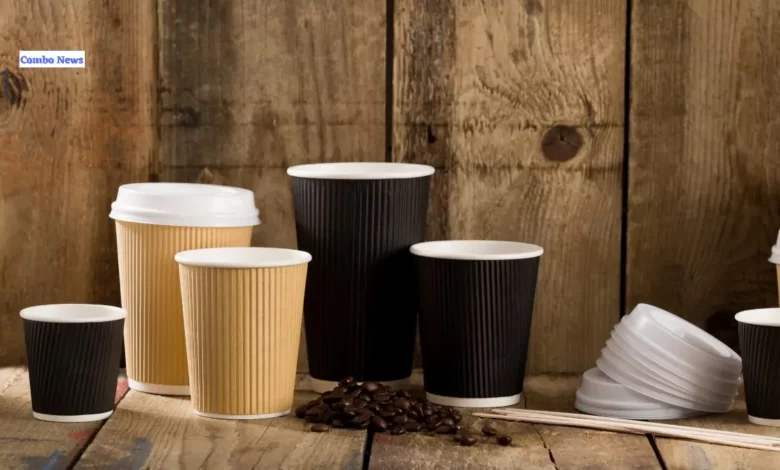Dangers of Drinking Coffee from Paper Cup

Table of Contents
Coffee from Paper Cup: For many, the day begins with the familiar ritual of sipping on a hot cup of coffee, often acquired from the local café or a quick stop at the office coffee machine. The convenience of a paper cup seems undeniable—portable, disposable, and seemingly harmless. However, beneath the comforting aroma and the steam rising from that takeaway cup, there lurk potential dangers that coffee enthusiasts may not be aware of.
Dangers of Coffee in Paper Cup

The Chemical Conundrum: Paper Cup Components
While it’s easy to overlook, paper cups are not just vessels for your daily caffeine fix; they are a composite of various materials. Many disposable cups are lined with a thin layer of polyethylene, a type of plastic that prevents leaks but poses a threat when in contact with hot liquids. When hot coffee comes into contact with this plastic lining, it can lead to the leaching of harmful chemicals into your drink, introducing an unintended toxic element to your morning routine.
Also Read | Benefits of Buttermilk That You Must Know, More Details Inside
Temperature Trouble: Hot Brew, Hot Risks
Coffee is typically served at a temperature that can exceed 140 degrees Fahrenheit, a level that poses a risk not only to your taste buds but potentially to your health. When hot liquid interacts with the plastic lining of a paper cup, the heat accelerates the release of chemicals, such as BPA (Bisphenol A), known for its endocrine-disrupting properties. Prolonged exposure to these chemicals has been linked to various health issues, including hormonal imbalances, reproductive complications, and an increased risk of certain cancers.
Environmental Impact: Brewing a Storm
The love for coffee contributes to an enormous environmental footprint, with millions of paper cups ending up in landfills each day. The process of manufacturing these cups involves cutting down trees, and the energy-intensive production of the plastic lining further exacerbates the environmental toll. Opting for a reusable cup or supporting businesses that encourage sustainability can significantly mitigate the environmental impact of your coffee consumption.
Microplastics in Every Sip: The Unseen Invaders
As plastic breaks down over time, microscopic particles known as microplastics infiltrate the environment. Studies have shown that hot liquids, especially those in contact with plastic, accelerate the release of these tiny plastic particles. Consuming microplastics through your daily coffee may have unintended health consequences, as these particles have been found in various tissues and organs, raising concerns about their long-term effects on human health.
Hidden Calories in the Cup: The Creamy Surprise
For those who enjoy their coffee with a dash of cream, the paper cup may be contributing to an unanticipated caloric intake. The plastic lining can absorb fatty molecules from the cream, leading to an inadvertent consumption of additional calories. While the individual calorie count may be negligible, the cumulative effect over time can contribute to weight gain and other health concerns.
Also Read | Top 14 Worst Foods for Stomach: A Guide to Your Belly Health
Caffeine Dependency: The Double-Edged Sword
Beyond the physical composition of the cup, the convenience of disposable coffee cups may be perpetuating a deeper issue—the growing dependency on caffeine. The ease of grabbing a cup on the go can contribute to habitual consumption, potentially leading to increased caffeine intake and its associated health risks, including insomnia, increased heart rate, and dependency-related withdrawal symptoms.
Allergic Reactions: The Unseen Culprit
Paper cups are often manufactured with a combination of materials, and some individuals may find themselves unknowingly exposed to allergens. Those with sensitivities to certain compounds used in the production of paper cups may experience allergic reactions, ranging from mild discomfort to more severe symptoms. Understanding the composition of disposable cups and opting for alternatives can be crucial for individuals with known allergies.
The Myth of Biodegradability: Greenwashing in the Coffee Industry
Many consumers choose paper cups under the assumption that they are a more environmentally friendly option due to their perceived biodegradability. However, the reality is more complex. The plastic lining in most paper cups hinders the biodegradation process, making these seemingly eco-friendly choices less sustainable than meets the eye. Exploring truly biodegradable alternatives or embracing reusable options remains the more environmentally responsible choice.
Financial Strain: Brewing a Hole in Your Pocket
The convenience of grabbing a coffee in a disposable cup may seem appealing, but the financial costs can add up over time. While individual cups may not break the bank, the cumulative expenses of daily coffee runs can strain your budget. Investing in a reusable cup not only benefits the environment but also provides a cost-effective solution for avid coffee drinkers.
Also Read | 7 Benefits of Eating a Fruit a Day

Key Facts:
1. Paper cups are often lined with polyethylene, a plastic that can leach harmful chemicals when in contact with hot liquids.
2. The temperature of hot coffee can accelerate the release of chemicals like BPA, which is linked to hormonal imbalances and reproductive issues.
3. The environmental impact of disposable cups is significant, contributing to deforestation and increased energy consumption in production.
4. Microplastics, released when plastic breaks down, can be found in hot coffee and may have long-term health consequences.
5. The plastic lining of paper cups can absorb fatty molecules from cream, adding unintended calories to your coffee.
6. Convenience-driven coffee consumption may contribute to caffeine dependency and its associated health risks.
7. Paper cups may contain allergens, leading to allergic reactions in sensitive individuals.
8. The biodegradability of paper cups is limited by the plastic lining, challenging their status as an eco-friendly option.
9. Choosing reusable cups can be a more cost-effective option for daily coffee drinkers.
10. Sipping safely and sustainably involves being aware of the potential dangers of disposable cups and making informed choices for both personal health and the environment.
Dangers of Coffee in Disposable Cups – Conclusion: Sip Safely, Sip Sustainably
As you savor that morning cup of coffee, it’s essential to be mindful of the vessel that holds your beloved brew. The seemingly innocuous paper cup, with its hidden perils, raises concerns about both personal health and environmental impact.
In an era where sustainability and well-being are at the forefront of consumer choices, reconsidering how we consume our daily coffee is not just a matter of preference but a step towards a healthier, greener future.
FAQs
What is the secure way of making coffee?
“Use a reusable silicone or glass cup for your hot takeout drinks to reduce your consumption of microplastics. It’s far better for the environment and your health, “he continued.
Also Read | Here Are 5 Protein Rich Snack Ideas That You Must Try To Increase Your Protein Intake








